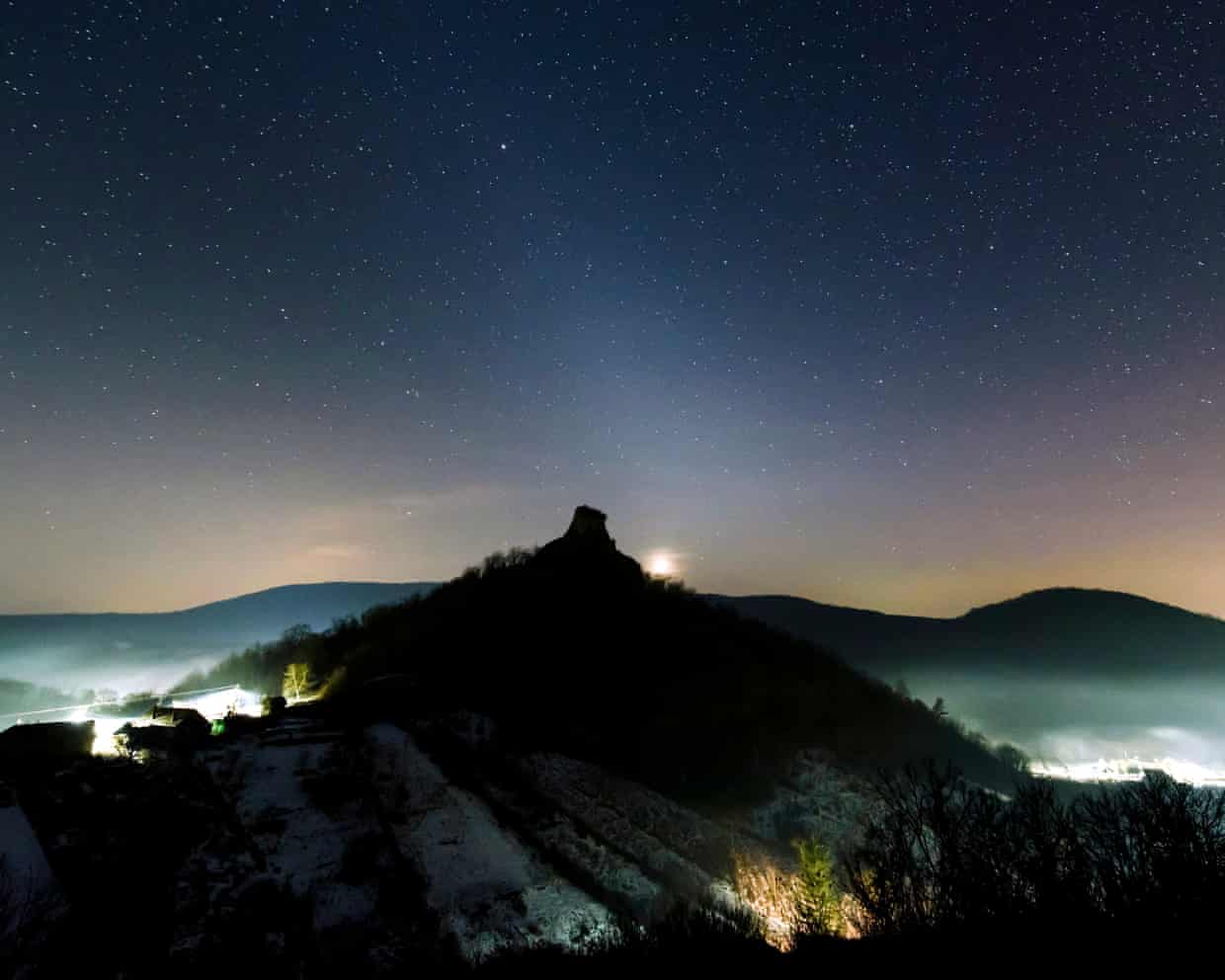Science
Skywatchers Gaze at Zodiacal Light: A Celestial Phenomenon

This week, skywatchers around the globe have the opportunity to observe the zodiacal light, a subtle yet captivating celestial phenomenon. This soft glow results from sunlight scattering off interplanetary dust, which originates from comets and collisions between asteroids. The zodiacal light manifests as a faint triangular shape that stretches upward from the horizon, creating a unique spectacle visible during specific times of the year.
Optimal Viewing Conditions
The zodiacal light is best seen around the time of the equinox, which occurred on March 20, 2024. During this period, the plane of our solar system, known as the ecliptic, rises steeply from the western horizon. To catch a glimpse of this astronomical event, observers should choose the darkest location available, ideally with an unobstructed view of the eastern horizon.
In the United Kingdom, the best time to begin observations is approximately one hour before dawn twilight starts, which translates to around 04:00 local time. Observers are encouraged to identify the constellations of Leo and Cancer, as the zodiacal light will appear in this region of the sky. The glow resembles the early dawn but can be distinguished by its wedge-like appearance that extends upwards.
Viewing in the Southern Hemisphere
For those situated in the Southern Hemisphere, the viewing conditions are somewhat reversed. The zodiacal light becomes visible about one hour after sunset, emerging from the western horizon. Observers will see a soft wedge of light stretching through the constellations of Virgo and Libra. This unique pattern offers a remarkable contrast to the evening sky and adds to the allure of stargazing.
As the zodiacal light is a transient phenomenon, skywatchers are encouraged to seize the opportunity to witness this enchanting display. With its origins rooted in the remnants of our solar system’s formation, the sight of this celestial glow serves as a reminder of the beauty and complexity of the universe.
-

 Education3 months ago
Education3 months agoBrandon University’s Failed $5 Million Project Sparks Oversight Review
-

 Science4 months ago
Science4 months agoMicrosoft Confirms U.S. Law Overrules Canadian Data Sovereignty
-

 Lifestyle3 months ago
Lifestyle3 months agoWinnipeg Celebrates Culinary Creativity During Le Burger Week 2025
-

 Health4 months ago
Health4 months agoMontreal’s Groupe Marcelle Leads Canadian Cosmetic Industry Growth
-

 Science4 months ago
Science4 months agoTech Innovator Amandipp Singh Transforms Hiring for Disabled
-

 Technology4 months ago
Technology4 months agoDragon Ball: Sparking! Zero Launching on Switch and Switch 2 This November
-

 Education4 months ago
Education4 months agoRed River College Launches New Programs to Address Industry Needs
-

 Technology4 months ago
Technology4 months agoGoogle Pixel 10 Pro Fold Specs Unveiled Ahead of Launch
-

 Business3 months ago
Business3 months agoRocket Lab Reports Strong Q2 2025 Revenue Growth and Future Plans
-

 Technology2 months ago
Technology2 months agoDiscord Faces Serious Security Breach Affecting Millions
-

 Education4 months ago
Education4 months agoAlberta Teachers’ Strike: Potential Impacts on Students and Families
-

 Education3 months ago
Education3 months agoNew SĆIȺNEW̱ SṮEȽIṮḴEȽ Elementary Opens in Langford for 2025/2026 Year
-

 Science4 months ago
Science4 months agoChina’s Wukong Spacesuit Sets New Standard for AI in Space
-

 Business4 months ago
Business4 months agoBNA Brewing to Open New Bowling Alley in Downtown Penticton
-

 Business4 months ago
Business4 months agoNew Estimates Reveal ChatGPT-5 Energy Use Could Soar
-

 Technology4 months ago
Technology4 months agoWorld of Warcraft Players Buzz Over 19-Quest Bee Challenge
-

 Business4 months ago
Business4 months agoDawson City Residents Rally Around Buy Canadian Movement
-

 Technology2 months ago
Technology2 months agoHuawei MatePad 12X Redefines Tablet Experience for Professionals
-

 Technology4 months ago
Technology4 months agoFuture Entertainment Launches DDoD with Gameplay Trailer Showcase
-

 Top Stories3 months ago
Top Stories3 months agoBlue Jays Shift José Berríos to Bullpen Ahead of Playoffs
-

 Technology4 months ago
Technology4 months agoGlobal Launch of Ragnarok M: Classic Set for September 3, 2025
-

 Technology4 months ago
Technology4 months agoInnovative 140W GaN Travel Adapter Combines Power and Convenience
-

 Science4 months ago
Science4 months agoXi Labs Innovates with New AI Operating System Set for 2025 Launch
-

 Technology4 months ago
Technology4 months agoNew IDR01 Smart Ring Offers Advanced Sports Tracking for $169








